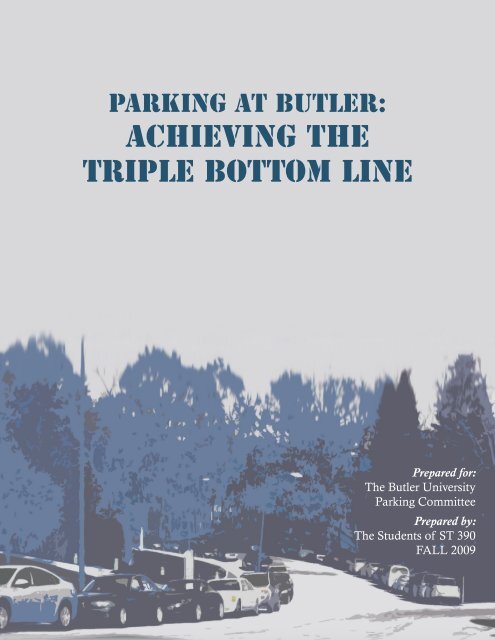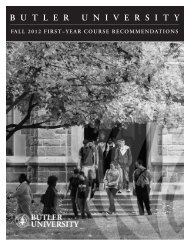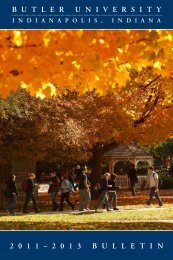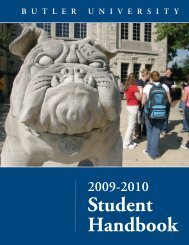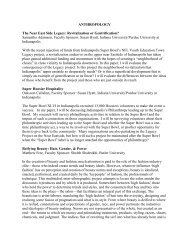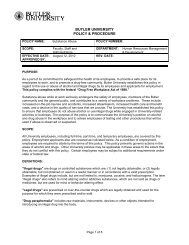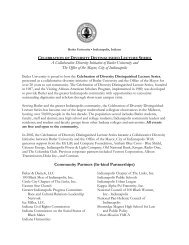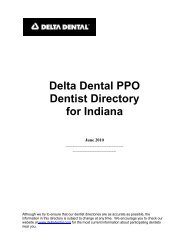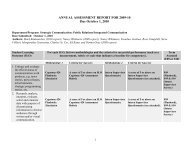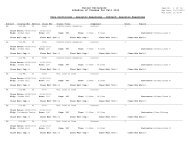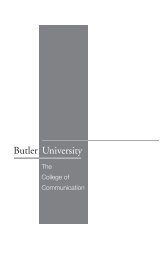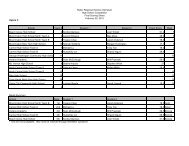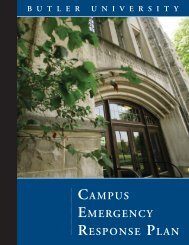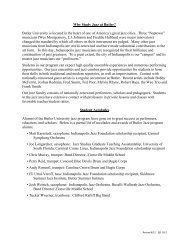Achieving the Triple Bottom Line - Butler University
Achieving the Triple Bottom Line - Butler University
Achieving the Triple Bottom Line - Butler University
Create successful ePaper yourself
Turn your PDF publications into a flip-book with our unique Google optimized e-Paper software.
PARKING AT BUTLER:<br />
<strong>Achieving</strong> <strong>the</strong><br />
<strong>Triple</strong> <strong>Bottom</strong> <strong>Line</strong><br />
Prepared for:<br />
The <strong>Butler</strong> <strong>University</strong><br />
Parking Committee<br />
Prepared by:<br />
The Students of ST 390<br />
FALL 2009
Parking at Buler: <strong>Achieving</strong> <strong>the</strong> <strong>Triple</strong> <strong>Bottom</strong> <strong>Line</strong> Table of Contents<br />
I. Project Overview .........................................................................................................4<br />
.<br />
II. Introduction .........................................................................................................5<br />
•<br />
•<br />
•<br />
Problem Statement<br />
Background<br />
Stakeholders<br />
III. Inventory .........................................................................................................7<br />
•<br />
•<br />
•<br />
•<br />
•<br />
•<br />
Historical data<br />
Context<br />
Current Conditions<br />
Interview<br />
Survey<br />
Trends<br />
IV. Analysis .........................................................................................................13<br />
•<br />
•<br />
•<br />
•<br />
Conflicts<br />
Successes<br />
Case Studies<br />
Costs<br />
V. Applications .........................................................................................................20<br />
•<br />
•<br />
•<br />
Issues and Recommendations<br />
Areas for fur<strong>the</strong>r investigation<br />
Summary<br />
VI. References ..........................................................................................................26<br />
VII. Appendices ........................................................................................................28<br />
•<br />
•<br />
•<br />
•<br />
•<br />
•<br />
Appendix A: Transcript of Interview with BUPD 29<br />
Appendix B: IRB survey permission 31<br />
Appendix C: Survey Questions 32<br />
Appendix D: Case study summaries 33<br />
Appendix E: Survey results summary 40<br />
Appendix F: Maps 42
Parking at <strong>Butler</strong><br />
4<br />
I. Project Overview<br />
This report was prepared by <strong>the</strong> students of <strong>the</strong> Fall 2009 ST 390, Environmental Policy Seminar,<br />
course. Our class participants include <strong>the</strong> following eight students: Ryan Danley, Julie Elmore,<br />
Kaitlin Haskins, Rich Hofstetter, Terri Lee, Andrew Matters, Kari Maxwell and Sara McDermand.<br />
This report is a summary of our five week investigation of parking policy and its related issues at<br />
<strong>Butler</strong> <strong>University</strong>. This project was conducted to provide <strong>the</strong> newly established parking committee<br />
with more insight into <strong>the</strong> parking issues at <strong>Butler</strong>.<br />
Parking is an issue that all students, staff, faculty and visitors must contend with at <strong>Butler</strong> <strong>University</strong>.<br />
As part of our Environmental Policy course, we looked at <strong>the</strong> parking policy at <strong>Butler</strong> in order<br />
to gain real world experience in reading, evaluating, and recommending policy. Parking at <strong>Butler</strong><br />
was chosen as our topic because it is currently being discussed among campus policy makers and<br />
is something that affects us and our peers. It also was a topic we could evaluate utilizing <strong>the</strong> triple<br />
bottom line, or <strong>the</strong> “People, Planet, Profit” model. The course was Environmental Policy so <strong>the</strong><br />
ecological issues related to parking practices could not be ignored.<br />
We followed a basic inventory, analysis and syn<strong>the</strong>sis process and were allotted five weeks to complete<br />
<strong>the</strong> project. We recognize some areas for fur<strong>the</strong>r improvement, including our survey and cost<br />
investigations. Given more time, <strong>the</strong> survey design could be improved upon and expanded to capture<br />
more information and include a larger percentage of <strong>the</strong> campus community. More time would<br />
also allow for an in depth analysis of our survey responses. Our cost investigations could be more<br />
refined and perhaps include a cost estimate for alternative designs and sites on campus. Lastly, we<br />
feel fur<strong>the</strong>r feasibility studies of our recommendations would improve <strong>the</strong> overall product.
II. Introduction<br />
PROBLEM STATEMENT<br />
There is a perception of a lack of parking on campus. In reality <strong>the</strong>re are enough parking spaces<br />
to accommodate <strong>the</strong> current car user on campus. The perception of a lack of space is more a<br />
function of people not always being able to park in front of <strong>the</strong>ir destination. Fur<strong>the</strong>rmore, <strong>the</strong><br />
current number of parking spaces at <strong>Butler</strong> is not sufficient to sustain a growing population of<br />
student, staff and faculty car users. Additionally, <strong>the</strong> historic solution to campus parking pressure<br />
has been <strong>the</strong> use of conventional parking, or surface parking lots constructed of asphalt.<br />
This solution is cost effective in <strong>the</strong> short term, but provides no ecological sensitivity to <strong>the</strong><br />
surrounding infrastructure and native systems.<br />
Due to our urban-suburban context and limited space, dealing with increased parking demands<br />
and locating new parking lots is a challenge. As a result, new parking spaces and lots have invaded<br />
pedestrian areas and <strong>the</strong> core of campus. As a residential campus, parking should be<br />
viewed as a privilege for students. Additionally, <strong>the</strong> focus of campus planning and circulation<br />
should be to <strong>the</strong> pedestrian first, automobile second.<br />
The best way to deal with this issue is through policy and design. Our project seeks to make<br />
recommendations that enhance <strong>the</strong> current parking policy and achieve a triple bottom line, that<br />
is a policy that addresses social, environmental and economic concerns. We feel <strong>the</strong> policy<br />
should provide social responsibility to stakeholders, economic viability, and be sensitive to <strong>the</strong><br />
land. The goal is to make our parking system ecologically sustainable while improving use for<br />
stakeholders.<br />
BACKGROUND<br />
The perceived lack of parking spaces is causing a multitude of problems for users on campus.<br />
The main problems include <strong>the</strong> issuance of an average of 5,922 tickets per academic year over<br />
<strong>the</strong> last three years, complaints by residents and commuters, tardiness by all parties, and tension<br />
toward parking officials as well as BUPD. Parking tickets are often issued due to people<br />
parking in lots for which <strong>the</strong>ir parking pass is not designated. If just one person parks out of<br />
place, it causes a domino effect because when <strong>the</strong>y park out of <strong>the</strong>ir designated area, a person<br />
who has a pass assigned to that area also has to park out of place.<br />
This year alone, 3,848 parking decals were sold while <strong>the</strong> total number of parking spaces on<br />
campus is only 3,150. This discrepancy in decals sold is reflective of <strong>the</strong> rotating amount of<br />
vehicles on campus at any given time, with <strong>the</strong> peak time period being approximately 8:00<br />
a.m. to 3:00 p.m. This time period is also <strong>the</strong> time period that parking lot restrictions are enforced.<br />
According to Andy Ryan, assistant chief of <strong>the</strong> <strong>Butler</strong> <strong>University</strong> Police Department,<br />
<strong>the</strong>re is no current limit on <strong>the</strong> number of parking decals sold.<br />
Lack of additional space for expansion of parking lots is causing a delay in <strong>the</strong> progression<br />
of solutions to <strong>the</strong> parking issue, so a comprehensive plan is required to work with <strong>the</strong> limited<br />
space on campus. We suggest that prior to expansion of parking, all options are considered<br />
to reduce <strong>the</strong> number of vehicles on campus, and promote walking and bicycling as well as<br />
<strong>the</strong> use of o<strong>the</strong>r environmentally friendly methods of travel. <strong>Butler</strong> <strong>University</strong> is primarily a<br />
ST 390 :: Final Report :: Fall 2009<br />
5
Parking at <strong>Butler</strong><br />
6<br />
II. Introduction<br />
residential campus, so any policy must take into account pedestrian usage of <strong>the</strong> infrastructure<br />
and make <strong>the</strong> campus easily accessible.<br />
For <strong>the</strong> purposes of our project we have defined stakeholders as ‘an individual, group, or company<br />
that can affect or be affected by parking policies established at <strong>Butler</strong> <strong>University</strong>’. We<br />
have identified several stakeholders (Table 1) with an interest in <strong>the</strong> parking policies at <strong>Butler</strong>.<br />
Table 1. Parking Stakeholders<br />
STAKEHOLDER RELEVANCE ESTIMATED<br />
USAGE*<br />
Students resident and commuter students who bring<br />
a car to campus<br />
Daily<br />
Faculty faculty members who bring a car to campus Daily<br />
Staff staff members who bring a car to campus Daily<br />
Visitors any non-registered visitors who bring a car<br />
to campus<br />
Daily<br />
Pedestrians anyone who walks to, from and on campus<br />
(may be a student, staff, faculty or visitors)<br />
Daily<br />
Bike Riders anyone who bikes to, from and on campus<br />
(may be a student, staff, faculty or visitor)<br />
Daily<br />
<strong>Butler</strong>-Tarkington surrounding neighbors within eight blocks<br />
N.D.<br />
Residents<br />
of campus<br />
Delivery/ Pick Up any delivery or pick up service that must<br />
Daily<br />
Services<br />
access campus ( Ray’s trash, USPS, FedEx,<br />
UPS, Aramark, etc. )<br />
Indianapolis Metro Patrol traffic, issue citations outside of<br />
Weekly<br />
Police Dept.<br />
campus<br />
CSG Security event and parking control company Weekly<br />
Public Transit any public transit in <strong>the</strong> area ( IndyGo,<br />
taxis, campus shuttle)<br />
N/A<br />
Local Bike Companies (Bike <strong>Line</strong>, Bicycle Hospital, BGI) N/A<br />
Public Works Maintain public infrastructure ( DPW,<br />
Veolia, United Water)<br />
N/A<br />
Utilities Companies Maintain and supply energy ( IPL, Duke<br />
energy, citizens gas)<br />
N/A<br />
Donors provide support and guidance to<br />
<strong>Butler</strong> <strong>University</strong><br />
N.D.<br />
Ecosystem flora and fauna found on or around campus,<br />
this resource is impacted by campus<br />
activity<br />
Daily<br />
Canal/ White River water resources adjacent to campus,<br />
resources impacted by campus activity<br />
Daily<br />
*N.D. = not determined, unable to estimate <strong>the</strong> number and frequency for this stakeholder<br />
*N/A = not applicable, <strong>the</strong>se stakeholders may not access campus, but have an interest in <strong>the</strong> issue
III. Inventory<br />
HISTORICAL DATA<br />
In more recent years parking on campus has drastically changed and become an important issue.<br />
As enrollment increases and <strong>the</strong> university grows <strong>the</strong>re are more students, visitors, faculty, and<br />
staff regularly traveling to campus by car. This amounts to a growing demand for space to store<br />
<strong>the</strong>se cars on a daily basis.<br />
We have seen many differences in <strong>the</strong> past 14 years, from <strong>the</strong> 1995 Master Plan to <strong>the</strong> current<br />
(2009) Master Plan being produced. When comparing information one noticeable change that<br />
is a great reflection of today’s society is that people appear to have slowed down in <strong>the</strong> past<br />
fourteen years. In 1995 it took approximately four minutes to walk from <strong>the</strong> center of campus<br />
(Norris Plaza) to <strong>the</strong> curve of Sunset and 48th Street. The current master plan states that it takes<br />
approximately five minutes to get from <strong>the</strong> center of campus to <strong>the</strong> beginning of <strong>the</strong> pond in<br />
front of <strong>the</strong> bell tower (approximately halfway up Lake Rd). This slowing down in approximate<br />
walking pace may be partially due to changes in <strong>the</strong> layout of <strong>the</strong> campus and increased traffic<br />
in <strong>the</strong> center of campus.<br />
There is a discrepancy between <strong>the</strong> circulation maps in <strong>the</strong> two master plans. A major issue is<br />
that Hinkle, <strong>the</strong> HRC, and Apartment Village are no longer included on <strong>the</strong> 2009 master plan<br />
circulation map, which is contrary to <strong>the</strong> increase in traffic, both vehicular and pedestrian, in<br />
that area of campus in recent years. With <strong>the</strong> increase in traffic in that area it should not be left<br />
out of current and future planning endeavours. This same map also excludes Lake Road as a pedestrian<br />
conflict. There are many bicycle users that have to share <strong>the</strong> road with vehicles, and due<br />
to <strong>the</strong> narrow sidewalk pedestrians, on occasoin, must also share <strong>the</strong> road with both vehicles and<br />
bicyclists. The Hinkle Parking lot is not listed as a pedestrian route, though it is very common for<br />
Village residents to cut through <strong>the</strong> parking lot on <strong>the</strong> way to and from <strong>the</strong> Apartment Village.<br />
CONTEXT<br />
<strong>Butler</strong> <strong>University</strong> is best classified as an urban-suburban campus. It is located approximately six<br />
miles from <strong>the</strong> heart of downtown Indianapolis and is surrounded by <strong>the</strong> <strong>Butler</strong>-Tarkington residential<br />
neighborhood to <strong>the</strong> north and east, <strong>the</strong> town of Rocky Ripple to <strong>the</strong> north and west, <strong>the</strong><br />
central canal and White River to <strong>the</strong> west, and more residential neighborhoods and <strong>the</strong> Crown<br />
Hill Cemetery to <strong>the</strong> South.<br />
Additionally, <strong>Butler</strong> is classified as a residential campus, with most freshman, sophomores and<br />
juniors being required to live on campus. The urban context of <strong>the</strong> campus translates into a<br />
multitude of amenities for campus residents. <strong>Butler</strong> is located approximately three miles from<br />
<strong>the</strong> Broad Ripple cultural district which offers local eateries, night clubs, music venues and boutique<br />
shopping. Several cultural and entertainment amenities are also located within a few miles<br />
of campus including <strong>the</strong> Indianapolis Museum of Art and <strong>the</strong> Indianapolis Arts Center. Table<br />
2 outlines a list of more regularly visited and common daily destinations and <strong>the</strong>ir proximity to<br />
campus.<br />
ST 390 :: Final Report :: Fall 2009<br />
7
Parking at <strong>Butler</strong><br />
8<br />
III. Inventory<br />
Table 2. Distance to frequently used destinations<br />
DESTINATION DESCRIPTION LOCATION DISTANCE<br />
(MILES)<br />
IndyGo Public Transportation two routes: 38th & Clarendon,<br />
and 46th and<br />
Illinois<br />
approx. 1<br />
Walgreens Pharmacy 711 E. 38th Street 2.4<br />
3003 Kessler Blvd. 4<br />
1530 N Meridian St. 4<br />
5675 N. Michigan St. 4<br />
CVS Pharmacy 1545 N. Meridian St. 4<br />
2975 Lafayette Rd. 5<br />
119 W. 56th Street 1.1<br />
6290 N. College Ave. 2.1<br />
Whole Foods Grocery Store 1300 E. 86th Street 6.6<br />
Kroger Grocery Store 524 E. 16th Street 2.5<br />
2630 W. Michigan St. 3.4<br />
6220 Guilford Ave. 3.9<br />
5718 Crawfordsville Rd. 4.9<br />
Fresh Market Grocery Store 5415 N. College Ave 2.1<br />
Safeway Grocery Store 5602 N. Illinois St. 1.1<br />
Walmart Retail/ Dept. Store 4545 Lafayette Rd. 4.2<br />
7325 N. Keystone Ave. 5.3<br />
3221 W. 86th St. 6.7<br />
Target Retail/ Dept. Store 6101 N. Keystone Ave. 4<br />
6925 W. 38th Street 7<br />
1300 E. 86th Street 7<br />
Marion County<br />
Library<br />
Library 4180 N. College Ave. 1.8<br />
40 E. St. Claire Street 11<br />
5420 E. 38th Street 6<br />
6101 N. Keystone Ave. 4<br />
CURRENT CONDITIONS<br />
Currently, all <strong>Butler</strong> students, regardless of commuter or residential status, are offered <strong>the</strong> option<br />
to purchase a parking pass. All students, faculty and staff that will bring a vehicle to<br />
campus are required to register <strong>the</strong>ir vehicle with BUPD. The current decal fee is $50.00 per<br />
academic year. Violation fees are $25.00, and must be paid in order to register for classes or<br />
renew your parking decal.
III. Inventory<br />
Figure 1: Distribution of campus parking spaces by parking lot<br />
Vehicle users are issued a decal based on <strong>the</strong>ir classification (resident, commuter, greek, faculty/staff).<br />
These designations determine which lots a vehicle may park in. There are a total of<br />
3,150 parking spaces on campus. Figure 1 details <strong>the</strong> distribution of <strong>the</strong>se spaces on campus.<br />
There are three types of parking spaces encountered on campus: perpendicular parking, parallel<br />
parking and 45 degree angled parking. During our inventory of campus we noted that <strong>the</strong>re<br />
is no uniformity in <strong>the</strong> dimensions of <strong>the</strong>se spots on campus (Table 3).<br />
Table 3. Parking space dimensions across campus<br />
LOCATION TYPE LENGTH WIDTH<br />
Lake Road Parallel 20’ 9’ 6”<br />
Pharmacy Bldg. Parallel 22’ 2” 9’<br />
Perpendicular 17’ 11” 8’ 7”<br />
Angled 17’ 9’ 6”<br />
Lilly Hall Parallel 19’ 9” 9’ 4”<br />
Angled 26’ 6” 12’<br />
Hinkle Perpendicular 17’ 8” 8’ 8”<br />
Schwitzer Perpendicular 18’ 5” 8’ 2”<br />
Clowes Angled 19’ 4” 7’ 9”<br />
ResCo Perpendicular 18’ 2” 8’ 2”<br />
Angled 25’ 4” 8’ 7”<br />
ST 390 :: Final Report :: Fall 2009<br />
9
Parking at <strong>Butler</strong><br />
10<br />
III. Inventory<br />
INTERVIEW<br />
Andy Ryan, <strong>the</strong> assistant chief of police and BUPD, was interviewed (Appendix A) about several<br />
different aspects of parking around <strong>Butler</strong>. There are 3,150 parking spots on campus, and<br />
3,848 parking decals were sold this year. See Figure 2 for a distribution of decal types sold and<br />
<strong>the</strong> corresponding number of spots available.<br />
Figure 2: Decals Sold in 2009 Versus Spaces Available<br />
There is currently no limit on <strong>the</strong> number<br />
of decals sold. There have been<br />
3,166 parking tickets given out so far<br />
this semester, with a yearly average of<br />
approximately 6,000. The most ticketed<br />
lot is at Clowes Hall, followed by <strong>the</strong><br />
Resco parking lot.<br />
There have only been 300 appeals<br />
to parking tickets this semester. So<br />
far, this academic year has generated<br />
$216,955.00 from tickets and decals,<br />
and $7,751.54 has been generated from<br />
<strong>the</strong> metered parking spots. This helps<br />
fund <strong>the</strong> BUPD operating budget and<br />
helps pay for lot maintenance and painting.<br />
Any additional money goes to <strong>the</strong><br />
university general operating budget.<br />
There have been additional bike racks placed around campus due to <strong>the</strong> increase of students<br />
riding bikes to and from campus. Three years ago IndyGo had a formal stop on campus, but<br />
because of <strong>the</strong> lack of use from people on campus it was cancelled. The closest stops are now at<br />
38th and Clarendon, and at Illinois and 46th. When Dr. Fong first became president at <strong>Butler</strong>,<br />
<strong>the</strong> issue of restricting freshman from bringing cars to campus was discussed. However, due<br />
to a lack of available public transportation and <strong>the</strong> fact that some students attend off campus<br />
internships, it was never acted upon.<br />
SURVEY<br />
As part of our inventory we conducted a survey of <strong>the</strong> <strong>Butler</strong> community utilizing Survey-<br />
Monkey.com. The use of SurveyMonkey had some limitations, specifically being limited to ten<br />
survey questions and 100 respondents. In an attempt to increase <strong>the</strong> number of respondents we<br />
established four surveys based on <strong>the</strong> following classifications: residential student, commuter<br />
student, faculty or staff. However, each survey presented identical questions to participants<br />
(Appendix C).<br />
We designed our survey in a way that we felt addressed why stakeholders used <strong>the</strong>ir cars. However,<br />
due to our student user bias, we feel in retrospect that <strong>the</strong> survey focused on student usage<br />
more so than <strong>the</strong> usage of faculty and staff. This caused some confusion regarding our answers
III. Inventory<br />
as did <strong>the</strong> way we chose to classify answer groups for questions 6 and 7. Future survey design<br />
about parking issues should take <strong>the</strong>se things into consideration.<br />
Overall we found that students, when walking from <strong>the</strong>ir cars to <strong>the</strong>ir primary destinations,<br />
were evenly distributed. For each of <strong>the</strong> following responses; less than three minutes, three to<br />
five minutes, six to 10 minutes, or 10+ minutes; <strong>the</strong> distribution of student responses was even<br />
across all of <strong>the</strong> choices, at approximately 25% each. Comparatively, approximately 87% of<br />
faculty and staff walk less than five (5) minutes to <strong>the</strong>ir primary destinations. We also found<br />
that students utilize more alternative transportation (walking, biking, etc.) than faculty and<br />
staff. The survey responses indicated that faculty were more open to carpools than students<br />
were. We feel this is most likely linked to <strong>Butler</strong>’s status as a residential campus, thus many<br />
students do not need to carpool to commute to campus.<br />
In regards to <strong>the</strong> cost of a parking decal we found that about 58% of respondents felt <strong>the</strong> price<br />
was high or too high, while <strong>the</strong> remaining 42% felt <strong>the</strong> price was low or cheap. We also feel it<br />
is important to note that 3% of faculty respondents would be willing to pay a higher amount<br />
for parking decals.<br />
The last question of <strong>the</strong> survey was open ended to allow for more detailed responses. We noticed<br />
several recurring <strong>the</strong>mes in response to <strong>the</strong> question ‘What are your concerns on parking<br />
on <strong>Butler</strong>’s campus. What would you do to improve those concerns?’ It seems as though a major<br />
complaint of <strong>the</strong> student population is <strong>the</strong> parking situation at Ross and Schwitzer Hall. In<br />
Ross <strong>the</strong> main complaint is <strong>the</strong> lack of parking spots and <strong>the</strong> fact that Sigma Chi reserves many<br />
of <strong>the</strong> parking spaces and does not use <strong>the</strong>m. For Schwitzer <strong>the</strong> complaints state <strong>the</strong> parking<br />
for <strong>the</strong> students (residents) is limited and <strong>the</strong>re is too much parking for faculty and staff in <strong>the</strong><br />
area. Respondents also felt <strong>the</strong>re are a great number of unregistered vehicles parking in <strong>the</strong> lot<br />
that aren’t ticketed.<br />
“I am upset about <strong>the</strong> Sigma Chi reserved spots in Ross’s parking lot. There is never anyone parked <strong>the</strong>re<br />
and it seems like a waste of space to let none of <strong>the</strong> Ross residents part <strong>the</strong>re. Sigma Chi has <strong>the</strong>ir own<br />
parking lot. Why do <strong>the</strong>y need to invade on Ross’s too? It upsets me because I <strong>the</strong>n have to park over in<br />
ResCo and often times it is at night and dark. Then I have to walk all <strong>the</strong> way to Ross by myself and it<br />
is a little sketchy. To improve my concerns I would say open up all of Ross parking lot to Ross residents.”<br />
Thu, Nov 19, 2009 9:55 AM<br />
A second <strong>the</strong>me we noticed in our survey responses is related to parallel parking. Respondents<br />
expressed that <strong>the</strong>re needs to be improved parallel parking spaces and clarification (via signage)<br />
of which areas are not parking spaces, such as <strong>the</strong> parallel parking zones around Ross and <strong>the</strong><br />
Greek houses. Respondents reported that <strong>the</strong> designated zones are not marked adequately. Respondents<br />
also expressed a desire for clearly delineated parallel spaces through striping.<br />
“I think for <strong>the</strong> greek houses, <strong>the</strong> street needs to be lined. Parallel parking is hard to do for some and if<br />
<strong>the</strong>re were lines, <strong>the</strong>re would be less accidents.” Thu, Nov 19, 2009 10:15<br />
ST 390 :: Final Report :: Fall 2009<br />
11
Parking at <strong>Butler</strong><br />
12<br />
III. Inventory<br />
TRENDS<br />
When reviewing parking policy and parking lots at <strong>Butler</strong> many trends can be seen. The first<br />
notable trend is that parking spaces on <strong>the</strong> university’s campus come in many different shapes<br />
and sizes. This shows a lack of uniformity and may be limiting <strong>the</strong> number of spots that could<br />
possibly fit in an area. There is also a notable lack of sensitivity towards non-motorists. One<br />
great concern is <strong>the</strong> absence of <strong>the</strong> Health and Recreation Complex (HRC), Hinkle, and <strong>the</strong><br />
Apartment Village in <strong>the</strong> updated 2009 Master Plan pedestrian map. This ignores <strong>the</strong> recent<br />
increase in traffic from Apartment Village residents, commuters parking in <strong>the</strong> Hinkle lot, and<br />
<strong>the</strong> numerous students visiting <strong>the</strong> HRC on a daily basis. Being that this is a residential campus<br />
and students are expected to walk to class each day it is important to put pedestrians in high<br />
priority. By catering to our transportation needs first we have created a campus that has ripe<br />
with conflict zones where pedestrians and cars meet.<br />
The campus has also continued to use conventional solutions and should research and consider<br />
investing in o<strong>the</strong>r possible solutions such as pervious surfaces or parking structures. There has<br />
been some mention of structures, but it seems to be difficult to finance currently due to current<br />
parking decal fees. Ano<strong>the</strong>r trend, or lack of trend, is no shift towards o<strong>the</strong>r green practices<br />
which may include pervious surfaces or incentives for alternate modes of transportation. There<br />
currently seems to be a disconnect between to ‘intent’ for a residential, pedestrian campus that<br />
encourages safety and convenience for pedestrians and bicyclists ra<strong>the</strong>r than <strong>the</strong> convenience<br />
for motorists who want to park immediately outside <strong>the</strong>ir intended destination.
IV. Analysis<br />
CONFLICTS<br />
<strong>Butler</strong> <strong>University</strong>’s campus has several areas of conflict that need to be examined and considered<br />
for revision. There are areas of circulation of traffic that cause a conflict between pedestrians<br />
and vehicles on a daily basis. Lake Road, for example, is currently a two way street that<br />
is not friendly to people biking or walking. The sidewalk is very narrow and it contains light<br />
poles in several locations. Bikers are not able to safely ride <strong>the</strong>ir bike on <strong>the</strong> road because <strong>the</strong><br />
amount of cars coming from both directions. They are forced to ei<strong>the</strong>r dodge traffic, or ride on<br />
<strong>the</strong> sidewalk and interfere with <strong>the</strong> traffic of <strong>the</strong> walkers.<br />
The physical space on <strong>Butler</strong>’s campus is limited due to surrounding neighborhoods and neighboring<br />
land. If <strong>Butler</strong> needs to expand it campus, this could be a problem in <strong>the</strong> future because<br />
of <strong>the</strong> lack of space available for expansion.<br />
The planning and design around <strong>Butler</strong>’s campus has improved over <strong>the</strong> last few years, but<br />
<strong>the</strong>re is still room for improvement. Pedestrian walkways are often difficult to differentiate<br />
from <strong>the</strong> actual road. Pedestrians often do not use <strong>the</strong> walkways because of this, and this can<br />
be a safety hazard. <strong>Butler</strong> is a residential campus and considered pedestrian friendly, and <strong>the</strong><br />
roads and walkways should be designed to promote this aspect of campus.<br />
SUCCESSES<br />
As <strong>Butler</strong> has developed and grown over <strong>the</strong> years, <strong>the</strong>re are several areas around campus that<br />
we considered areas of success. Along Hampton Drive <strong>the</strong>re are several crosswalks that are<br />
clearly marked with bold stripping. These crossings are used on a daily basis, instead of pedestrians<br />
walking across an unmarked area along Hampton Drive. If more of <strong>the</strong> crosswalks<br />
around campus had this bold stripping, we feel <strong>the</strong>y would be taken advantage of by pedestrians.<br />
The number of people using bikes to travel to and from campus has increased over <strong>the</strong> years<br />
and <strong>Butler</strong> has adapted to this increase. To accommodate bicyclists <strong>the</strong>re have been several bike<br />
racks added around campus. If <strong>Butler</strong> continues to provide more bike racks around campus, we<br />
feel <strong>the</strong> number of students who bring bikes to campus will increase.<br />
There is parking available within a reasonable walking distance from almost every destination<br />
around campus. <strong>Butler</strong> has provided designated parking areas for all residences, Greek, faculty<br />
and staff, and commuter vehicle users. In addition to having designated parking areas for all<br />
groups, <strong>the</strong>re is currently no limitations set on registering cars to bring to campus. All students,<br />
faculty and staff are afforded <strong>the</strong> right to register and use <strong>the</strong>ir vehicle on campus.<br />
CASE STUDIES<br />
An important factor to consider in resolving <strong>the</strong> parking issues on <strong>Butler</strong>’s campus is <strong>the</strong> parking<br />
policies of o<strong>the</strong>r comparable universities. Examples from four universities will follow and<br />
summaries of all case studies can be found in Appendix D.<br />
ST 390 :: Final Report :: Fall 2009<br />
13
Parking at <strong>Butler</strong><br />
14<br />
IV. Analysis<br />
Based on our research, many Universities require students and faculty to pay a higher cost for<br />
<strong>the</strong> privilege of parking than is required of students and faculty at <strong>Butler</strong>. The trend has continued<br />
even after <strong>the</strong> price increase of parking decals for <strong>the</strong> 2009-2010 school year with three out<br />
of four of <strong>the</strong> highlighted schools continuing <strong>the</strong> pattern.<br />
The ticketing practice of each of <strong>the</strong> universities was a main aspect that we analyzed. One<br />
university whose ticketing practice stood out was Valparaiso <strong>University</strong>. In <strong>the</strong>ir system, <strong>the</strong>re<br />
is a base price for infractions, but <strong>the</strong>re is also an additional fee that is added to <strong>the</strong> final ticket<br />
price contingent upon <strong>the</strong> violator’s number of infractions. At Valparaiso, six total infractions<br />
in one academic year results in a loss of <strong>the</strong> privilege of having a car on campus.<br />
Valparaiso <strong>University</strong> Violation Fee Structure:<br />
Violation fees<br />
First violation in an academic year $10.00<br />
Second violation in an academic year $15.00<br />
Third violation in an academic year $25.00<br />
Forth violation in an academic year $35.00<br />
Fifth and each succeeding violation in an academic year $45.00<br />
Fines<br />
Driving or parking on grass violation + $25.00<br />
Unregistered vehicle violation + $50.00 + $105.00<br />
*$50 fine will be waived if registration is paid within 7 business days<br />
Falsification on registration form violation + $25.00 + $105.00<br />
Unauthorized transfer of registration violation + $25.00<br />
Parking in zone restricted to disabled violation + $50.00<br />
Parking in fire lane/zone violation + $50.00<br />
Reckless driving or driving left of center violation + $50.00<br />
Disregarding stop sign violation + $25.00<br />
Seat Belt violation violation + $15.00<br />
A sixth violation in an academic year may result in revocation of campus vehicle registration,<br />
impoundment of <strong>the</strong> vehicle and loss of campus driving privileges<br />
Two o<strong>the</strong>r universities that stood out in our research were Emerson College in Boston, Massachusetts<br />
and Notre Dame <strong>University</strong> in South Bend, Indiana for both having car-free, pedestrian<br />
campuses. Emerson’s car-less policy is due to <strong>the</strong> availability of public transportation.<br />
Notre Dame’s pedestrian friendly campus is due to <strong>the</strong> limitation of vehicular traffic in <strong>the</strong><br />
center of campus. On Notre Dame’s campus, both students and faculty are required to park at<br />
<strong>the</strong> periphery of campus. Parking inside <strong>the</strong> main part of campus is limited to one (1) hour and<br />
requires a special permit obtained upon entering of campus.
IV. Analysis<br />
Summary of Notre Dame Parking Policy<br />
Parking Permits Policy- Registered vehicles are given decals with designated lots, lots are<br />
given letter names. Certain lettered decals are valid in o<strong>the</strong>r lettered lots. Passes into <strong>the</strong> heart<br />
of campus are an hour in length and can be obtained from gate officers.<br />
*Preferred Parking program for Low Emitting Vehicles; a total of 23 spots are available in<br />
five lots. <strong>University</strong> motor pool has five hybrid vehicles in its fleet. TRANSPO bus is free<br />
with student ID. Staff/Faculty shuttle. Web conferencing available in campus for all faculty,<br />
staff, and students, to discourage unnecessary car trips.<br />
Ohio Wesleyan became of interest due to its lottery based decal system. Upperclassmen gain<br />
priority in receiving parking decals and <strong>the</strong> remaining spots are allotted to <strong>the</strong> sophomores and<br />
freshmen via a lottery system.<br />
Summary of Ohio Wesleyan <strong>University</strong> Parking Policy:<br />
Parking Stats:<br />
Student Lot: Yes<br />
Freshman allowed to park: Yes-Limited<br />
Parking Permit Cost: $65<br />
Parking Permit Policy:<br />
Juniors and seniors can purchase permits in <strong>the</strong> first two weeks of each semester. The<br />
process is quick and easy, as long as you have your car registration information. For freshmen<br />
and sophomores, <strong>the</strong> process is a bit trickier, as <strong>the</strong>re is a lottery determined by how<br />
many spaces are still available. There is still a chance for first- or second-year students to get<br />
a permit, and even if <strong>the</strong>y don’t, it is simple to park on <strong>the</strong> street in close vicinity to all <strong>the</strong><br />
dorms.<br />
Many of <strong>the</strong>se Universities have clear parking policies that are easy to find and available to<br />
students on <strong>the</strong> <strong>University</strong>’s website. In contrast to <strong>Butler</strong>’s two sentence vague policy that does<br />
not clearly define <strong>the</strong> role of parking on campus nor <strong>the</strong> intention of <strong>the</strong> university regarding<br />
parking. It also fails to mention that parking is a privilege and not a right.<br />
WALKABILITY<br />
Walkability refers to <strong>the</strong> ability for pedestrians to move between destinations. There are two<br />
major factors that influence <strong>the</strong> walkability of a city or town: institutional precedence and<br />
pre-auto urban design. In general, people are willing to walk one-quarter to one-half mile on<br />
foot to arrive at a destination. Any distance longer than that and people want to use a method<br />
of transportation. The shortest distance to a grocery store is <strong>the</strong> Safeway at 56th and Illinois,<br />
approximately one mile. This means that, in general, all of <strong>the</strong> routine destinations close to<br />
<strong>Butler</strong>’s campus are out of <strong>the</strong> comfortable walking distance for campus residents. However,<br />
ST 390 :: Final Report :: Fall 2009<br />
15
Parking at <strong>Butler</strong><br />
16<br />
IV. Analysis<br />
given <strong>the</strong> size of campus, it is reasonable to encourage students, faculty and staff alike to travel<br />
in and around campus by foot. Additionally, as a residential campus, every effort to improve<br />
pedestrian conditions on campus should be made and maintained to improve <strong>the</strong> walkability<br />
of campus.<br />
BIKABILITY<br />
Now with <strong>the</strong> recent developments with <strong>the</strong> Student Government Association sponsored shuttle<br />
service, <strong>Butler</strong> students without access to a car are may be fur<strong>the</strong>r confined to <strong>the</strong> campus.<br />
There are some IndyGo stops within approximately one mile of campus, however <strong>the</strong> IndyGo<br />
system is not as reliable or well developed as o<strong>the</strong>r city’s mass transit options. Additionally,<br />
traveling by foot to bus stops and <strong>the</strong> stops <strong>the</strong>mselves are perceived by many as unsafe. Traveling<br />
by bicycle is a reliable, affordable and healthy option for students, staff and faculty. Given<br />
our proximity to <strong>the</strong> Tow Path, bicyclists can access shopping and entertainment destinations<br />
easily, safely and without having to travel on busy roads.<br />
The downside is a marked lack of bicycling infrastructure on campus. Riding a bike on sidewalks<br />
is dangerous and illegal. <strong>Butler</strong> bicyclists must share <strong>the</strong> sidewalk with pedestrians or<br />
share access drives with automobiles on campus. Additionally it is difficult for residential<br />
students to store bikes safely and easily while still having year round access. If biking infrastructure<br />
were expanded and improved, it would likely encourage more students to use bikes<br />
on and around campus.<br />
PARKING<br />
The parking lot is <strong>the</strong> first and <strong>the</strong> last part of a building or campus to be viewed by <strong>the</strong> user.<br />
It is <strong>the</strong> gateway through which many students, visitors, and employees pass. This first<br />
impression is very important to <strong>the</strong> overall feeling and atmosphere conveyed to <strong>the</strong> user. Developers<br />
and property owners want <strong>the</strong>ir facilities to be attractive, well designed, and<br />
functional. Though many hours are spent on producing aes<strong>the</strong>tically pleasing building<br />
designs, <strong>the</strong> same design consideration for <strong>the</strong> parking area is often overlooked. Parking areas<br />
that are poorly designed can experience excessive maintenance problems and a shortened<br />
service life. In addition, selecting <strong>the</strong> right materials for a parking area can assure a pleasing<br />
and attractive surface. When properly designed and constructed, parking areas can be an<br />
attractive part of a campus or building that is also safe, and usable. Parking areas should be<br />
designed for low maintenance costs and easy modification for changes in use patterns.<br />
Landscaping should also be considered when designing parking lots. Effective landscaping can<br />
reduce <strong>the</strong> ‘heat island’ effect experienced in parking lots. Landscape materials create screens<br />
that block views to large, open parking areas, and create an illusion of green space. Landscape<br />
islands create pockets of pervious surface within <strong>the</strong> parking lot as well.<br />
Surface Parking<br />
A typical parking space is 8-10 feet (2.4-3.0 meters) wide and 18-20 feet (5.5-6.0 meters) deep,<br />
totaling 144-200 square feet (13-19 sq. meters). To construct one off street parking lot that will
IV. Analysis<br />
accommodate 100-150 spaces requires approximately one acres of land, depending on design.<br />
This figure is based on 300-350 square feet per space. Of <strong>the</strong> 300-350 square feet, approximately<br />
200 is alotted for actual parking and <strong>the</strong> remainder allows for access lanes and landscaping.<br />
Operation and maintenance costs include cleaning, lighting, maintenance, repairs, security,<br />
landscaping, snow removal, access control (e.g., entrance gates), fee collection (for priced parking),<br />
enforcement, insurance, labor and administration. Parking facilities require resurfacing<br />
and repaving every 5-10 years, and parking structures require major reconstruction or replacement<br />
after 20-40 years, with higher maintenance costs in areas with harsh climates, particularly<br />
with frequent salt exposure. Parking structures may require elevators, fire control and mechanical<br />
ventilation.<br />
The parking standard at <strong>Butler</strong> <strong>University</strong> is a surface parking lot constructed of asphalt. There<br />
are multiple problems with <strong>the</strong> use of asphalt, <strong>the</strong> primary being that it is not environmentally<br />
friendly. Asphalt is impervious which means stormwater and any o<strong>the</strong>r type of precipitation<br />
cannot be absorbed into <strong>the</strong> ground. This inhibits groundwater recharge and fur<strong>the</strong>r taxes <strong>the</strong><br />
stormwater and sewer systems. Impervious surfaces also increase erosion to areas adjacent to<br />
parking lots. Asphalt and o<strong>the</strong>r impervious surfaces increases <strong>the</strong> albedo, or surface heat, of <strong>the</strong><br />
parking lot. This heat can reflect to buildings, increasing it’s cooling needs and stress trees and<br />
landscaping material. While it is understandable that asphalt is used because it is <strong>the</strong> cheapest<br />
solution, <strong>the</strong>re are alternatives that will pay for <strong>the</strong>mselves in o<strong>the</strong>r areas and are environmentally<br />
friendly.<br />
Parking Structures<br />
Basic parking structures cost about $1,500 per space from one source, and $3,000 to $4,000<br />
per space according to ano<strong>the</strong>r. This variation is dependent on <strong>the</strong> amount of infrastructure<br />
needed, i.e. storm sewers, asphalt, lighting, and striping. An above ground parking structure<br />
that would accommodate <strong>Butler</strong> would cost around $12,000 to $15,000 per space. Again, <strong>the</strong>re<br />
is a range in <strong>the</strong> price per space depending on <strong>the</strong> type of construction, number of special features<br />
added, and location of <strong>the</strong> garage.<br />
Costs: $1,500- 4,000 per space ($7.50 - 20.00 per square foot based on 200 sq.ft. space). Variation<br />
is <strong>the</strong> result of necessary infrastructure, design, and local market costs.<br />
Traditional Pavement<br />
The formula for traditional pavement is made of a 95% aggregate of stone, sand, or gravel and<br />
5% asphalt cement as a binder. This binder is <strong>the</strong> product of oil refining and is used to glue <strong>the</strong><br />
aggregates toge<strong>the</strong>r. Asphalt is a fossil fuel product that retains heat and temperature around<br />
buildings and prevents water penetration.<br />
ST 390 :: Final Report :: Fall 2009<br />
17
Parking at <strong>Butler</strong><br />
18<br />
IV. Analysis<br />
Costs: $3.25- 4.25 per square foot. This cost includes <strong>the</strong> excavation and installation along<br />
with <strong>the</strong> materials and labors.<br />
Porous Pavement<br />
Porous pavements can provide a cost-effective pavement with a life span of more than 20 years.<br />
The porous pavement can at <strong>the</strong> same time provide storm water management systems through<br />
<strong>the</strong> permeable pavement. The porous pavement is successful because it provides storm water<br />
and runoff a place to go in <strong>the</strong> form of an underlying open-graded stone bed. The water drains<br />
through <strong>the</strong> porous asphalt, <strong>the</strong>n into <strong>the</strong> stone bed and <strong>the</strong>n slowly infiltrates <strong>the</strong> soil. The<br />
stone bed size us usually 18 to 36 inchs in depth. The stone bed is more expensive than conventional<br />
construction, but <strong>the</strong> cost is more than offset by <strong>the</strong> elimination of many of <strong>the</strong> standard<br />
elements of standard-storm water management systems. The porous pavement also has been<br />
seen to have a high removal rate for total suspended solids, metals, oils, and greases in <strong>the</strong> water.<br />
It is also a “cooler” choice due to <strong>the</strong> open structure of <strong>the</strong> pavement.<br />
Example: The Walden Pond State Reservation in Massachussetts contains a porous pavement<br />
lot constructed in 1977 that is still maintained and drains effectively today. This porous<br />
lot has never been repaved throughout its existence.<br />
Costs: $9.50 per square foot for excavation, installation, and materials and labor cost.<br />
Grass Pave & Gravel Pave<br />
Ano<strong>the</strong>r possible alternative is Grass Pave or Gravel Pave which are systems that are strong<br />
enough to accommodate vehicles, just as a standard parking lot would. The system uses strong<br />
plastic cells that provide structure and are covered with grass or turf. Grass pave parking lots<br />
could also double as recreation areas when not in use for parking.<br />
The benefits to Grass Pave systems are that <strong>the</strong>y reduce surface temperatures around buildings,<br />
permit surface water filtration and drainage, and eliminate need for a catch basis system. The<br />
grass pave system is made of reinforced plastic cells that hold <strong>the</strong> grass roots, <strong>the</strong>re is a second<br />
type is an area with open spacers that allow gaps between pavers, in <strong>the</strong>se gaps gravel of grass<br />
is placed in to allow <strong>the</strong> replenishment of groundwater. Installation takes 2 to 3 months to develop<br />
<strong>the</strong> root system from seed. Installation can occur immediately if turf is used.<br />
Costs: $9.00-12.00 per square foot based on <strong>the</strong> product quality (heavy vs. light)<br />
Parking Cost Summary<br />
When asphalt is <strong>the</strong> only material being used, <strong>the</strong>re is little concern for environment. However,<br />
as we have found, an alternative parking garage or structure presents a higher initial cost. The<br />
current parking decal fee at <strong>Butler</strong> is low when compared to o<strong>the</strong>r institutions. These fees could
IV. Analysis<br />
be raised in order to fund <strong>the</strong> installation and maintenance of alternative parking systems, such<br />
as multi level garages, or <strong>the</strong> use of alternative materials as future needs arise. A new parking<br />
garage can make many more parking spaces than a traditional parking lot and could be placed<br />
on a existing parking lot and would be more beneficial in <strong>the</strong> long run.<br />
ST 390 :: Final Report :: Fall 2009<br />
19
Parking at <strong>Butler</strong><br />
20<br />
V. Applications<br />
As a result of our inventory and analysis we have identified multiple issues that affect <strong>the</strong> stakeholders<br />
identified earlier is this report. All of <strong>the</strong>se issues, we feel, are related in some way<br />
to <strong>the</strong> <strong>Butler</strong> <strong>University</strong> parking policy. These issues are related to <strong>the</strong> triple bottom line, that<br />
is <strong>the</strong> social, ecological and economic influences of <strong>the</strong> current policy. We have outlined our<br />
identified issues below and offer our recommendations to resolve <strong>the</strong> issues.<br />
ISSUE RECOMMENDATION<br />
Parking Policy Language: Current parking<br />
policy language is short and does not clearly<br />
speak to all aspects of parking on campus. It<br />
currently restricts where cars are parked but<br />
not who is allowed to park on campus. The<br />
language regarding parking in <strong>the</strong> neighborhood<br />
areas is vague and unclear.<br />
• Include language that parking is a privilege<br />
not a right<br />
• The <strong>University</strong> has <strong>the</strong> right to determine<br />
who parks on campus as well as where <strong>the</strong><br />
vehicles are parked on campus<br />
• Clarify neighborhood parking policy<br />
• Improve signage<br />
• To administer parking in an ecological and<br />
environmentally friend way including<br />
• Recognize that <strong>the</strong> land parking spaces require<br />
is valuable and limited<br />
• Parking decal fees and violation fees should<br />
reflect <strong>the</strong> valuation of land and space<br />
ISSUE RECOMMENDATION<br />
Design Standards: No consistent design<br />
standard exists for parking spaces on campus.<br />
There are a variety of sizes for every<br />
type of parking space (perpendicular, parallel,<br />
etc.). Only one paving material is used<br />
(asphalt) and not all available measures are<br />
taken to reduce environmental and ecological<br />
impacts.<br />
•Conduct site review and determine if re-striping<br />
for smaller spots or a different type of spot<br />
would create more spots overall<br />
• Determine a uniform dimension for each<br />
type of spot (angle: parallel, perpendicular,<br />
diagonal)<br />
• Designate a certain number of spots in each<br />
lot for compact cars<br />
• Designate a certain number of spots in each<br />
lot for hybrid or Low-Emission Vehicles (LEV)<br />
• Invest in pervious surfaces<br />
• Increase shade trees near lots, sidewalks, and<br />
roads to decrease heat in hotter temperatures<br />
ISSUE RECOMMENDATION<br />
Walking Time and Distance: Many people<br />
have concerns about <strong>the</strong> time it takes<br />
<strong>the</strong>m to walk from <strong>the</strong>ir cars to <strong>the</strong>ir offices<br />
or classes. It seems that any walk over approximately<br />
four minutes is perceived as a<br />
hardship.<br />
• Ignore <strong>the</strong>m and move parking fur<strong>the</strong>r towards<br />
<strong>the</strong> periphery of campus. This is more<br />
pedestrian friendly and consistent with a residential<br />
campus intent.
V. Applications<br />
ISSUE RECOMMENDATION<br />
Bikability: There is a marked lack of bicycling<br />
infrastructure on campus. Biking on<br />
sidewalks is dangerous and illegal, however<br />
<strong>Butler</strong> bicyclists must share <strong>the</strong> sidewalk<br />
with pedestrians or share access drives with<br />
automobiles on campus. Additionally it<br />
is difficult for residential students to store<br />
bikes safely, easily while still having access.<br />
If biking infrastructure were improved, we<br />
feel more people would turn to bicycling as<br />
an alternative mode of transportation.<br />
• Creation of Bike Lanes, specifically on<br />
Lake Road<br />
• Provide students with usable bike map for<br />
<strong>the</strong> surrounding area highlighting safest routes<br />
to destination<br />
• Create a Spring and Fall bike safety seminar<br />
series<br />
• Improvements to current bike storage<br />
policy<br />
• Increase <strong>the</strong> number of bike racks and create<br />
more user friendly bike rack/storage areas<br />
(i.e. covered, well lit, etc.)<br />
• Creation of a bike share or co-op open to<br />
all students, faculty and staff. A co-op could<br />
also be used as an incentive to encourage residential<br />
students to leave <strong>the</strong>ir cars at home.<br />
ISSUE RECOMMENDATION<br />
Walkability: <strong>Butler</strong> is a residential campus<br />
first, surrounded by urban-suburban neighborhoods.<br />
There is a lack of mass transit options<br />
for <strong>Butler</strong> students to travel to destinations<br />
off campus. These factors mean it is<br />
imperative to improve <strong>the</strong> walkability of <strong>the</strong><br />
campus to encourage safe pedestrian travel<br />
to and from campus, and on campus. The<br />
lack of attention to pedestrian needs is highlighted<br />
by ‘conflict zones’ at Norris Plaza and<br />
on Lake Road at <strong>the</strong> intersection between<br />
<strong>the</strong> Observatory and <strong>the</strong> Pharmacy Addition.<br />
• Highlight <strong>the</strong> pedestrian nature of campus<br />
• Improve crosswalks with bolder striping<br />
• Signage at major entrances notifying<br />
vehicles that this is a pedestrian campus<br />
• Adding rumble strips to slow down cars at<br />
<strong>the</strong> core of campus<br />
• Remove cars from <strong>the</strong> core of campus<br />
• Put in a crosswalk at <strong>the</strong> intersection of 46th<br />
Street and Sunset Avenue<br />
• Improved cleaning of sidewalks during winter<br />
months<br />
• Provide students with maps pinpointing<br />
busier intersections on campus<br />
• Improve <strong>the</strong> drainage of rainwater from campus<br />
sidewalks<br />
ST 390 :: Final Report :: Fall 2009<br />
21
Parking at <strong>Butler</strong><br />
22<br />
V. Applications<br />
ISSUE RECOMMENDATION<br />
Violation Fees: <strong>Butler</strong>’s current violation<br />
structure has a simple flat rate well below<br />
that of <strong>the</strong> IMPD. Increasing penalty fees<br />
offers <strong>the</strong> opportunity to financially support<br />
future parking policy needs and discourage<br />
unwanted parking patterns.<br />
• Restructuring <strong>the</strong> violation fees to:<br />
(1) create harsher penalties for certain violations<br />
such as parking in an ADA space;<br />
(2) create harsher penalties for repeat offenders.<br />
These harsher penalties should include <strong>the</strong> loss<br />
of parking privileges for those who exceed a<br />
set number of tickets in a single academic year.<br />
(See Valparaiso <strong>University</strong> fee structure for examples)<br />
ISSUE RECOMMENDATION<br />
Nightime Safety: Some students have raised<br />
issues with <strong>the</strong> state of nighttime safety on<br />
campus. For instance, some feel that <strong>the</strong><br />
mall area between A<strong>the</strong>rton Union, Irwin<br />
Library, and Residential College is poorly<br />
lit. This lack of adequate lighting creates an<br />
atmosphere that is uninviting and perceived<br />
as dangerous.<br />
• Increased foot/bike patrol by BUPD<br />
• Well developed escort service, increased<br />
awareness and advertisement<br />
• Increased awareness of <strong>the</strong> Code Blue Program<br />
and emergency phone locations<br />
ISSUE RECOMMENDATION<br />
Lake Road: This main access route is currently<br />
a major area of conflict between pedestrians<br />
and vehicles. The road consists of<br />
two vehicle lanes, and bicyclists are forced<br />
to ride on <strong>the</strong> sidewalk to avoid cars. It is<br />
difficult for bicyclists and pedestrians to<br />
travel on <strong>the</strong> three foot sidewalk provided.<br />
This causes a fur<strong>the</strong>r problem between <strong>the</strong><br />
walkers and <strong>the</strong> bikers.<br />
• Make 46th street <strong>the</strong> only entrance on <strong>the</strong><br />
East side of campus<br />
•Change Lake Rd. to one way street exiting<br />
on Sunset Ave.<br />
• Add a bike lane to Lake Rd. adjacent to <strong>the</strong><br />
sidewalk<br />
• Maintain <strong>Butler</strong> Way as a one way street in<br />
it’s current direction<br />
• Reverse <strong>the</strong> one way access roads in front of<br />
Lilly Hall and <strong>the</strong> Pharmacy Addition<br />
( See figure/ photo....)<br />
ISSUE RECOMMENDATION<br />
Asphalt Parking: Asphalt is a cheap material<br />
and may be <strong>the</strong> most economical solution<br />
up front. However, it comes with many<br />
negative side effects.<br />
• Investigate stacked parking options<br />
• For surface parking, adopt a policy of using<br />
semi-pervious or porous materials<br />
• Consider Grass-Pave for ‘overflow’ parking<br />
sites to maintain green space
V. Applications<br />
ISSUE RECOMMENDATION<br />
<strong>University</strong> Terrace (UT): UT is located on<br />
<strong>the</strong> very edge of campus, residents are ra<strong>the</strong>r<br />
isolated from <strong>the</strong> main campus and are<br />
given commuter parking passes, which enables<br />
residents to drive from <strong>the</strong> UT parking<br />
lot to <strong>the</strong> commuter parking lots on campus.<br />
Many residents feel uncomfortable walking<br />
from <strong>the</strong>ir apartment to <strong>the</strong> main campus<br />
because <strong>the</strong>re is not a well lit, frequently<br />
traveled route<br />
•Stop issuing commuter parking passes to UT<br />
residents<br />
• Discourage UT residents from driving <strong>the</strong> to<br />
<strong>the</strong> main campus by issuing resident passes<br />
• Address concerns of a safe walking route,<br />
including streetlights on 52nd Street between<br />
<strong>the</strong> Maintenance Facility and UT.<br />
• Increase BUPD presendce along <strong>the</strong> route<br />
from UT to campus<br />
• Additionally, BUPD is encouraged to patrol<br />
Holcomb Gardens and <strong>the</strong> Canal Towpath<br />
on a regular basis since UT residents also use<br />
<strong>the</strong>se routes to access campus<br />
ISSUE RECOMMENDATION<br />
Phi Psi Parking Lot: This lot is unsafe and<br />
unfriendly to both pedestrians and bicyclists.<br />
There are no distinct areas to walk<br />
within <strong>the</strong> lot, forcing pedestrians to maneuver<br />
around parked or moving vehicles.<br />
Both access drives in <strong>the</strong> lot are two way despite<br />
<strong>the</strong> minimal width. This is a high traffic<br />
area that contains Faculty, Greek, and<br />
Resident parking, along with a heavy flow<br />
of pedestrians at most times of <strong>the</strong> day.<br />
• Change <strong>the</strong> access drives in <strong>the</strong> lot to one<br />
way, <strong>the</strong> Eastern drive going North and <strong>the</strong><br />
Western drive going South<br />
• Visible walkways should be painted on <strong>the</strong><br />
drives to delineate where pedestrians are to<br />
safely walk to and from campus<br />
• These walkways should be on one side of<br />
<strong>the</strong> access drive, providing a clear indication<br />
of where it is safe to walk and cross roads in<br />
this lot<br />
ISSUE RECOMMENDATION<br />
Drop off access: We feel that many drivers<br />
would not mind a longer walk if <strong>the</strong>re were<br />
a process in place to unload heavy items<br />
prior to parking <strong>the</strong>ir cars.<br />
• provide 15 minute drop off spaces (as seen<br />
at Gallahue Hall) at several key locations<br />
around campus<br />
ISSUE RECOMMENDATION<br />
Parking Designation: Many complaints regarding<br />
parking on campus are due to commuters<br />
(faculty, staff and students) having<br />
to walk longer distances to <strong>the</strong>ir destination<br />
while residential students have <strong>the</strong>ir cars<br />
park closer to campus and outside of <strong>the</strong>ir<br />
dorms. Through re-designation of parking<br />
areas and policy changes, some of this tension<br />
may be alleviated.<br />
• Raise parking decal fees to encourage not<br />
bringing a car to campus<br />
• Eliminate freshmen cars on campus<br />
• or restrict some freshmen cars based on<br />
distance to home, have an application process<br />
for freshmen who need cars for internships<br />
• Implement a tiered parking decal system<br />
• Implement semester based parking decal<br />
system<br />
ST 390 :: Final Report :: Fall 2009<br />
23
Parking at <strong>Butler</strong><br />
24<br />
V. Applications<br />
ISSUE RECOMMENDATION<br />
Decal System: <strong>Butler</strong> university’s parking<br />
decals are significantly less expensive than<br />
o<strong>the</strong>r universities. If <strong>the</strong> price is increased,<br />
we could increase revenue and perhaps deter<br />
people from bringing <strong>the</strong>ir cars<br />
• maintain <strong>the</strong> current color-coded decals to<br />
correspond with <strong>the</strong> lot in which <strong>the</strong> person<br />
lives.<br />
• Resident parking passes should be limited<br />
and freshman should be given parking passes<br />
ei<strong>the</strong>r based on lottery or highest GPA. Provide<br />
documentation if <strong>the</strong>y have a job.<br />
• Increase price of passes to $100 or greater<br />
• Non- restricted increase price by $100<br />
•Set a limit on number of passes sold, first<br />
come, first serve.<br />
Revise decal types as follows:<br />
• Faculty/ Staff<br />
•Upperclassman Resident (junior-senior)<br />
•Freshman Resident<br />
•Commuter<br />
•Greek<br />
•“Non-restricted”<br />
-Can’t park in faculty and staff<br />
- higher price<br />
• Seasonal Pass - one semester only<br />
ISSUE RECOMMENDATION<br />
Incentives for Alternatives: The current<br />
parking system lacks incentives that encourage<br />
alternative methods. An incentive system<br />
could help with <strong>the</strong> parking problem by<br />
decreasing <strong>the</strong> number of cars on campus,<br />
which would make <strong>the</strong> campus greener, decrease<br />
<strong>the</strong> amount of parking needed, and<br />
improve <strong>the</strong> campus by encouraging more<br />
healthy alternatives.<br />
• Car pool passes: one discounted pass given<br />
to a group of 2 to 4 people who choose to carpool,<br />
<strong>the</strong> groups shares a parking hanger<br />
•If a person chooses to bring a bike instead<br />
of a car, a discount is given on <strong>the</strong>ir books for<br />
each semester that <strong>the</strong>y do not have <strong>the</strong>ir car<br />
• High decal fee for a non-restricted pass<br />
• 4-year lump sum decal fee at a discount<br />
offered to students, staff, faculty saves some<br />
money and provides increased revenue up<br />
front<br />
• We could also help <strong>the</strong> community by encouraging/<br />
pursuing improved public transportation<br />
options in <strong>the</strong> area. If instituted,<br />
an incentive system could set an example for<br />
o<strong>the</strong>r universities
ST 390 :: Final Report :: Fall 2009<br />
25
Parking at <strong>Butler</strong><br />
26<br />
VI. References<br />
Advanced Team Buildings Technologies & Practices. (2008). Reinforced Grass Paving Systems.<br />
Retrieved December 1, 2009, from Site Services: www.sustainablebuilding.com/Advanced<br />
Buildings/Reinforced Grass Paving Systems_files/main_t_site_grass_paving.htm<br />
<strong>Butler</strong> <strong>University</strong> (2009). Retrieved December 7, 2009, from BU Police Department - <strong>Butler</strong><br />
<strong>University</strong> - Parents & Family: http://www.butler.edu/parents/<br />
The Christner Partnership. (1995). Facilities Master Plan for <strong>Butler</strong> <strong>University</strong>. St. Louis.<br />
The Christner Partnership. (2009). Facilities Master Plan for <strong>Butler</strong> <strong>University</strong>. St. Louis.<br />
City of Portland. (2009). Turf Block. Retrieved November 30, 2009, from Portland Online:<br />
www.portlandonline.com/bes/index.cfm?a=127479&c=31870<br />
College Prowler. (2009). Retrieved December 1, 2009, from College Prowler:<br />
www.collegeprowler.com<br />
Cost to Build a Parking Garage. (2008). Retrieved November 19, 2009, from Urban Parking Concepts<br />
LLC.: www.urbanparkingconcepts.com/docs/info.html<br />
County, San Mateo. (2009). Turf Blcok and Permeable Joint Pavers. Retrieved November 30, 2009,<br />
from www.flowstobay.org.<br />
Denison <strong>University</strong>. (2009). Retrieved December 1, 2009, from Traffic and Parking:<br />
www.denison.edu/offices/controller/studentaccounts/traffic.html<br />
DePauw <strong>University</strong> (2009). General Parking Information. Retrieved December 2, 2009 from<br />
www.depauw.edu/student/safety/parking/<br />
Depauw <strong>University</strong>. (2009, December 1) Retrieved December 2, 2009 from<br />
http://en.wikipedia.org/wiki/DePauw_<strong>University</strong><br />
Earlham College. (2009). Retrieved December 1, 2009, from Vehicle Parking and Traffic<br />
Regulations: www.earlham.edu/policies/safety/vehicle.html<br />
Emerson College. (2009). Retrieved December 1, 2009, from Orientation:<br />
www.emerson.edu/student_life/orientation/Directions.cfm<br />
Harvard <strong>University</strong>. (2009). Retrieved November 30, 2009, from<br />
Transportation Services: www.uos.harvard.edu/transportation/parking/<br />
Constructive Advice. (Spring 2001). Retrieved November 19, 2009, from High Construction:<br />
www.highconstruction.com/hcc/Resources/ConstructiveAdvice/2001Spring/<br />
parkinggarages.html<br />
Hofstra <strong>University</strong>. (209). Retrieved December 1, 2009, from Public Safety:<br />
www.hofstra.edu/studentaffairs/PublicSafety/pubsaf_parking.html
VI. References<br />
Marian <strong>University</strong>: Parking and Ticket Regulations. (2009, August) Retrieved December 2,<br />
2009 from www.marian.edu/directions/pages/campusmap.aspx<br />
Marian <strong>University</strong> (Indiana). (2009, November 25) Retrieved December 2, 2009 from<br />
http://en.wikipedia.org/wiki/Marian_College_%28Indiana%29<br />
Ohio Wesleyan <strong>University</strong>. (2009). Retrieved December 1, 2009, from Parking Information:<br />
http://publicsafety.owu.edu/parkingInformation.html<br />
Permeable Pavement. (2001-2008). Retrieved 12 1, 2009, from Toolbase Services: http://www.tool<br />
base.org/Technology-Inventory/Sitework/permeable-pavement<br />
Porous Asphalt Parking Lot. (2006). Retrieved November 19, 2009, from Technical Series on<br />
District Office Demonstration Features: www.rwmwd.org/vertical/Sites<br />
Ramsey-Washington Water Management District. (2006). Porous Asphalt Parking Lot. Retrieved<br />
November 30, 2009, from RWMWD: http://www.rwmwd.org/vertical/Sites/<br />
Ryan, A. (2009, 18 November). Information Regarding Parking Policy. (S. McDermand, &<br />
R. Danley, Interviewers)<br />
SMRC. (2009). Better Site Design Fact Sheet: Alternative Pavers. Retrieved November 30, 2009, from<br />
Stormwater Center: www.stormwatercenter.net/Assorted Fact Sheets/Tool4_Site_Design/<br />
AlternativePavers.htm<br />
<strong>University</strong> of Indianapolis. (2009). Retrieved November 30, 2009, from Campus Growth and Change:<br />
www.uindy.edu/growth/index.php#parking<br />
<strong>University</strong> of Notre Dame. (2009). Retrieved November 30, 2009, from Parking and Traffic:<br />
http://ndsp.nd.edu/parking-and-traffic<br />
Valparaiso <strong>University</strong>: Parking Retrieved December 2, 2009 from Parking:<br />
www.valpo.edu/vupd/parking/index.php<br />
Valparaiso <strong>University</strong>. (2009, November 10) Retrieved December 2, 2009 from<br />
http://en.wikipedia.org/wiki/Valparaiso_<strong>University</strong><br />
Walkshed. (2008). Retrieved November 19, 2009, from Livable Streets:<br />
www.livablestreets.com/streetswiki/walking-shed<br />
ST 390 :: Final Report :: Fall 2009<br />
27
Parking at <strong>Butler</strong><br />
28<br />
VII. Appendices
Appendix A: Transcript of interview with BUPD<br />
1. Can you verify <strong>the</strong> number of spaces compared to <strong>the</strong> number of decals sold? 3150<br />
spots and 4,000 decals sold?<br />
841 - Commuter Students<br />
516 – Faculty<br />
483 – Greek Students<br />
28 – Faculty In Residence<br />
828 - Resident Students<br />
751 – Staff<br />
401 – Village Students<br />
3848 total<br />
2. Is <strong>the</strong>re a cutoff on <strong>the</strong> number of permits sold?<br />
There is no cutoff<br />
3. Would it be possible to raise <strong>the</strong> parking ticket and permit prices?<br />
Raised from $35 to $50 this year. Parking Committee will look at fee structure for fines and<br />
permits.<br />
4. Which parking lot gets <strong>the</strong> most tickets?<br />
The most ticketed lot is <strong>the</strong> Clowes lot. The ResCo lot is second.<br />
5. Who determines how many parking spots are needed per section and how often are<br />
<strong>the</strong>se updated/revised?<br />
Historical usage policy – close to residence halls are residence hall parking. Made changes<br />
based on policy. Vice Pres Mike Gardner makes decisions. Have stayed pretty consistent since<br />
he has been here. New lot or expand – decision is based on what is best suited. There are issues<br />
around Robertson, changed from Faculty/Staff to visitor.<br />
6. Do you think that it would be feasible to prohibit freshmen from having cars?<br />
When Dr Fong became President <strong>the</strong>y brought it up at dept meeting. Issue – no mass transit,<br />
more soph and freshman need internships, enrollment issue<br />
7. How often is <strong>the</strong> BUPD escort service used?<br />
Hours are darkness dusk to dawn, medical need can use it<br />
8. Have any mass transit partnerships been researched? With IndyGo? Campus taxi?<br />
Shuttle? Pay with flex dollars or cash ($2 flat rate)..<br />
3 years ago IndyGo had bus stop – was not utilized 38Th and Clarendon closest<br />
SGA pays for Thursday Friday Saturday night shuttle (cancelled now)<br />
9. What responsibilities are given to IMPD on campus compared to BUPD? Do <strong>the</strong>y work<br />
at events?<br />
BUPD has primary jurisdiction but IMPD can make arrest no parking tickets<br />
29
30<br />
Appendix A: Transcript of interview with BUPD<br />
10. Does <strong>Butler</strong> have any incentives for non-automobile commuting around campus?<br />
Bike Racks have increased to meet demands - no incentives<br />
11. How many tickets have been given out compared to past years?<br />
So far we have issued 3166 tickets this academic semester<br />
In 08-09 we issued 5924<br />
In 07-08 we issued 5458<br />
In 06-07 we issued 6384<br />
12. How many people appeal tickets?<br />
I have received 300 parking appeals this academic semester<br />
13. How many complaints around neighborhood?<br />
1 or 2 that are vocal and o<strong>the</strong>rs accept fact <strong>the</strong>re are students in neighborhood<br />
14. How has parking system been working in your words?<br />
Works well – 1 person to park where <strong>the</strong>y are not supposed to – policy says to register<br />
your car – more parking spaces – we have green space – would like to see incentives to not have<br />
cars – gated lots to restrict people to get in to lots (resident lots) – all boils down to how much<br />
money you would like to spend.<br />
So far this academic year we have generated $216,955 for decals and tickets. The revenue for<br />
<strong>the</strong> tickets and decals helps fund <strong>the</strong> BUPD operating budget and helps pay for lot maintenance<br />
and painting. Any additional money goes to <strong>the</strong> university general operating budget.<br />
Meter income for this academic semester is $7751.54 This money also goes back to <strong>the</strong> university<br />
operating budget. I cannot give you an accurate estimate on <strong>the</strong> number of visitors on<br />
campus daily.
Appendix B: IRB survey permission<br />
INSTITUTIONAL REVIEW BOARD<br />
DATE: November 18, 2009<br />
TO: Marjorie Hennessy<br />
CUE<br />
FROM: Robert Holm, Director<br />
Institute for Research and Scholarship<br />
RE: IRB Protocol<br />
TITLE: Parking at <strong>Butler</strong>: <strong>Achieving</strong> <strong>the</strong> <strong>Triple</strong> <strong>Bottom</strong> <strong>Line</strong><br />
SUBMISSION TYPE: New Study<br />
ACTION: DETERMINATION OF EXEMPT STATUS<br />
DECISION DATE: November 18, 2009<br />
On behalf of <strong>the</strong> Institutional Review Board (IRB), I am pleased to announce that your application<br />
for research involving human subjects has been approved as exempt. As such,<br />
<strong>the</strong>re will be no fur<strong>the</strong>r review of your protocol, and you are cleared to proceed with <strong>the</strong><br />
procedures outlined in your protocol.<br />
As an exempt study, <strong>the</strong>re is no requirement for continuing review. Your protocol will remain<br />
on file with <strong>the</strong> IRB as a matter of record. Although your study is exempt from a continuing<br />
review, you and your research team are not exempt from ethical research practices<br />
and should <strong>the</strong>refore employ all protections for your participants and <strong>the</strong>ir data which are<br />
appropriate to your project.<br />
The duration of <strong>the</strong> IRB approval is from November 18, 2009 to November 30, 2009. Any<br />
modifications to your protocol or any extension to <strong>the</strong> approval period must be evaluated by<br />
<strong>the</strong> IRB before being implemented, as some modifications may change <strong>the</strong> review status of<br />
this project<br />
I offer my congratulations on your approval and wish you success on your research.<br />
Should you desire additional assistance or clarification, please call me at 9845.<br />
31
32<br />
Appendix C: Survey questions<br />
1. Which of <strong>the</strong> following best applies to you?<br />
Faculty, Staff, Residential Student, Commuter Student, Campus Visitor<br />
2. On average, how long does it take you to walk from your car to your primary destination on<br />
campus?<br />
Under 3 minutes<br />
3-5 minutes<br />
6-10 minutes<br />
Over 10 minutes<br />
I don’t bring a car to campus<br />
3. Do you use any o<strong>the</strong>r types of transportation? Check all that apply.<br />
Walking, Biking, Public Transport, Car Pool, I only use my car<br />
4. Would you participate in a car pool?<br />
yes or no<br />
5. On average, how many days a week is your car on campus?<br />
1, 2, 3 , 4 ,5 6, or 7 days<br />
6. How often do you make multiple OFF campus car trips per day? (Example- Come for classes, go<br />
to lunch in Broad Ripple and come back for afternoon classes)<br />
1, 2, 3, 4, 5 days or more<br />
7. How often do you make multiple ON campus car trips per day? (Example- Drive from Schwitzer<br />
to <strong>the</strong> HRC)<br />
1 , 2, 3, 4, 5 days or more<br />
8. What are your reasons for traveling off campus by car? Check all that apply.<br />
to go to: work, home, grocery, social events, meals, shopping, cultural events, off campus<br />
courses<br />
9. Compared to o<strong>the</strong>r academic institutions parking fees how would you rate <strong>the</strong> cost of <strong>Butler</strong>’s<br />
parking pass?<br />
It’s cheap, It’s low enough I’ll pay, It’s a bit high but doable, It’s too high!, I’d pay more<br />
10. What are your concerns on parking on <strong>Butler</strong>’s campus. What would you do to improve those<br />
concerns?
Appendix D: Case study summaries<br />
Name of Institution: <strong>University</strong> of Indianapolis<br />
Type of Campus: Private, Residential<br />
Location: Indianapolis, IN; suburban<br />
Size: 4700 students (1100 graduate),<br />
Demographic: resident and commuter, in state and out of state students<br />
Quick Stats:<br />
• Student lots- Yes<br />
• Freshman allowed to park- yes<br />
• Price for pass- $0<br />
• Common Parking Tickets- not found<br />
Parking Permits Policy- Parking is a privilege allotted to all students, faculty, and staff free of<br />
charge.<br />
Name of Institution: <strong>University</strong> of Notre Dame<br />
Type of Campus: Residential, Private<br />
Location: Notre Dame, IN; suburban<br />
Size: 8,363 undergraduate, 1,250 acres<br />
Demographic: 80% of undergraduates live on campus;<br />
Quick Stats:<br />
• Student lots- Yes<br />
• Freshman allowed to park- yes; those in good standing at <strong>the</strong> end of <strong>the</strong>ir first semester<br />
may apply for a parking permit for <strong>the</strong>ir second semester on campus.<br />
• Price for pass- $75 (average)<br />
• Common Parking Tickets- $50 for parking on campus without a decal<br />
Parking Permits Policy- Registered vehicles are given decals with designated lots, lots are given<br />
letter names. Certain lettered decals are valid in o<strong>the</strong>r lettered lots. Passes into <strong>the</strong> heart of campus<br />
are an hour in length and can be gotten from gate officers.<br />
*Preferred Parking program for Low Emitting Vehicles; a total of 23 spots are available in five<br />
lots. <strong>University</strong> motor pool has five hybrid vehicles in its fleet. TRANSPO bus is free with student<br />
ID. Staff/Faculty shuttle. Web conferencing available in campus for all faculty, staff, and<br />
students, to discourage unnecessary car trips.<br />
Name of Institution: Harvard <strong>University</strong><br />
Type of Campus: residential, private<br />
Location: Cambridge, MA; urban<br />
Size: 6,678 Undergraduate (13,600 Graduate & Professional), 4,979 acres<br />
Demographic: undetermined<br />
Quick Stats:<br />
• Student lots- Yes as well as parking structures.<br />
• Freshman allowed to park- no<br />
• Price for pass- annually $965 - $1920<br />
• Common Parking Tickets- no parking zone and expired meter -$18<br />
33
34<br />
Appendix D: Case study summaries<br />
Harvard con’t:<br />
Parking Permits Policy- Students parking permits assigned on a space-available basis. Permits<br />
are: tenant, commuter, evening commuter, and summer (for students); reserved, unreserved,<br />
morning, afternoon, 3day, evening commuter, metered, tenant, and carpool (for f/s).Carpool<br />
incentive for faculty and staff.<br />
web: http://www.uos.harvard.edu/transportation/<br />
Name of Institution: Denison <strong>University</strong><br />
Size of Student Body: 2,211<br />
Control: Private(Semesters)<br />
Location: Granville, Ohio<br />
Setting: Suburban<br />
Parking Stats:<br />
Student Lot: Yes<br />
Freshman allowed to park: Yes<br />
Parking Permit Cost: $60<br />
Common Parking Tickets:<br />
Fire lane - $100<br />
Handicapped zone - $100<br />
No parking zone - $40<br />
Parking Permit Policy:<br />
Parking is a bit of a problem on campus. It isn’t that <strong>the</strong>re aren’t enough parking spaces,<br />
but parking spaces can be inconveniently located. Getting a parking permit at Denison is easy;<br />
it’s just a matter of paying <strong>the</strong> money to register your car. And unlike a lot of college campuses,<br />
freshmen are allowed to have a car on campus. So, incoming freshmen can consider <strong>the</strong>mselves<br />
lucky that <strong>the</strong>y can have a car on campus, but <strong>the</strong>y shouldn’t get too excited, because <strong>the</strong>re is a<br />
catch.<br />
Once you have a car on campus, you have to park it. It’s not really very difficult to park at Denison,<br />
but it can be inconvenient at times. As a freshman, you will only be able to park down <strong>the</strong><br />
hill by <strong>the</strong> far end of North Quad. As you progress through <strong>the</strong> years, parking gets easier and<br />
closer to <strong>the</strong> buildings in which you’ll live. There are a few places where it is difficult to find a<br />
spot, such as behind Curtis East, but <strong>the</strong> campus has built several new parking lots in <strong>the</strong> past<br />
few years beginning in 2001, and so are attempting to accomodate students and <strong>the</strong>ir vehicles.<br />
web: http://www.denison.edu/offices/controller/studentaccounts/traffic.html<br />
Name of Institution: Earlham College<br />
Size of Student Body: 1,168<br />
Control: Private(Semesters)<br />
Location: Richmond, Indiana<br />
Setting: Rural<br />
Parking Stats:<br />
Student Lot: Yes
Appendix D: Case study summaries<br />
Freshman allowed to park: Yes<br />
Parking Permit Cost: $40<br />
Common Parking Tickets:<br />
Handicapped Zone - $100<br />
Non-registration - $75<br />
O<strong>the</strong>r violations - $10 (increasing incrementally by $10 for each additional violation)<br />
Parking Permit Policy:<br />
Students must apply for a permit from Campus Safety and Security within two days of<br />
<strong>the</strong> beginning of classes or within two days of <strong>the</strong> vehicle’s presence on campus. Permits cost<br />
$40, and replacement tags cost $25.<br />
Faculty Parking:<br />
All Earlham employees are required to obtain and display parking tags for <strong>the</strong>ir vehicles<br />
in order to park in campus lots. There is no charge for <strong>the</strong> parking tags. Except for medical<br />
personnel and area directors, <strong>the</strong>re are no reserved parking spaces on campus. Employees are<br />
not permitted to use spaces on campus that are designated for short-term visitor parking during<br />
normal working hours. There are fines imposed for illegal and/or improper parking. Contact<br />
<strong>the</strong> Security Office for parking tags and additional information.<br />
web: http://www.earlham.edu/policies/safety/vehicle.html<br />
Name of Institution: Emerson College<br />
Size of Student Body: 3,346<br />
Control: Private(Semesters)<br />
Location: Boston, MA<br />
Setting: Urban<br />
Parking Stats:<br />
Student Lot: No<br />
Freshman allowed to park: No<br />
Parking Permit Cost: None Given<br />
Common Parking Tickets:<br />
Fire hydrant - $100<br />
Fire lane - $100<br />
Parking in residential area without a permit - $20<br />
Parking Permit Policy:<br />
Off-campus students may be able to secure a resident parking permit for <strong>the</strong>ir neighborhood.<br />
Keep in mind that Massachusetts registration and proof of residency will be required.<br />
These permits only assure you are parking near your home, and <strong>the</strong>y often have year-long waitlists.<br />
web: http://www.emerson.edu/student_life/orientation/Directions.cfm<br />
Name of Institution: Hofstra <strong>University</strong><br />
Size of Student Body: 7,570<br />
35
Appendix D: Case study summaries<br />
Hofstra con’t :<br />
Control: Private (Semesters)<br />
Location: Hempstead, NY<br />
Setting: Suburban<br />
Parking Stats:<br />
Student Lot: Yes<br />
Freshman allowed to park: Yes<br />
Parking Permit Cost: Free<br />
Common Parking Tickets:<br />
Faculty lot - $50<br />
Fire lane - $50<br />
Handicapped spot - $100<br />
No parking zone - $20<br />
Parking Permit Policy:<br />
There is no fee for student parking permits. However, every student must have <strong>the</strong>ir vehicle<br />
registered with <strong>the</strong> Department of Public Safety. Once registered, students receive a permit<br />
sticker that must be displayed somewhere on <strong>the</strong> vehicle at all times. This permit allows parking<br />
in all lots except for those specifically designated for faculty and staff. Disabled students with<br />
vehicles can obtain special parking permits with authorization from <strong>the</strong> Hofstra Health and<br />
Wellness Center.<br />
web: http://www.hofstra.edu/studentaffairs/PublicSafety/pubsaf_parking.html<br />
Name of Institution: Ohio Wesleyan <strong>University</strong><br />
Size of Student Body: 1,956<br />
Control: Private(Semesters)<br />
Location: Delaware, Ohio<br />
Setting: Suburban<br />
Parking Stats:<br />
Student Lot: Yes<br />
Freshman allowed to park: Yes-Limited<br />
Parking Permit Cost: $65<br />
Common Parking Tickets:<br />
No parking zone - $20<br />
Parking in a fire lane - $20<br />
Parking in a handicapped area - $40<br />
Parking with no permit - $20<br />
Parking Permit Policy:<br />
Juniors and seniors can purchase permits in <strong>the</strong> first two weeks of each semester. The<br />
process is quick and easy, as long as you have your car registration information. For freshmen<br />
and sophomores, <strong>the</strong> process is a bit trickier, as <strong>the</strong>re is a lottery determined by how many<br />
spaces are still available. There is still a chance for first- or second-year students to get a permit,<br />
and even if <strong>the</strong>y don’t, it is simple to park on <strong>the</strong> street in close vicinity to all <strong>the</strong> dorms.<br />
web: http://publicsafety.owu.edu/parkingInformation.html<br />
36
Appendix D: Case study summaries<br />
Name of Institution: Valparaiso <strong>University</strong><br />
Type of Campus: mainly residential, private<br />
Location: Valparaiso, IN, suburban<br />
Size: 2,917 undergrads, 957 postgrads, 310 acres<br />
Demographic: appears to be a residential campus, but <strong>the</strong>re are commuter students, unable to find<br />
information on percentages of each. Students from all states and 40 countries<br />
Quick Stats:<br />
• Student lots- Yes, lots<br />
• Freshman allowed to park- Yes, in freshman designated areas<br />
• Price for pass- $105<br />
• Common Parking Tickets: Violation fee + fine = total charge<br />
Violation fees<br />
First violation in an academic year $10.00<br />
Second violation in an academic year $15.00<br />
Third violation in an academic year $25.00<br />
Forth violation in an academic year $35.00<br />
Fifth and each succeeding violation in an academic year $45.00<br />
Fines<br />
Driving or parking on grass violation + $25.00<br />
Unregistered vehicle violation + $50.00 + $105.00<br />
*$50 fine will be waived if registration is paid within 7 business days<br />
Falsification on registration form violation + $25.00 + $105.00<br />
Unauthorized transfer of registration violation + $25.00<br />
Parking in zone restricted to disabled violation + $50.00<br />
Parking in fire lane/zone violation + $50.00<br />
Reckless driving or driving left of center violation + $50.00<br />
Disregarding stop sign violation + $25.00<br />
Seat Belt violation violation + $15.00<br />
A sixth violation in an academic year may result in revocation of campus vehicle registration, impoundment<br />
of <strong>the</strong> vehicle and loss of campus driving privileges<br />
Parking Permits Policy:<br />
a. Special parking areas are provided as a privilege for VU students and employees. Operators of<br />
registered vehicles have <strong>the</strong> privilege of parking in specified areas, but having a registered vehicle does<br />
not ensure <strong>the</strong> availability of a parking space. The responsibility of finding a legal parking space rests<br />
with <strong>the</strong> vehicle operator. Vehicle registration may be revoked for persons who are repeated violators<br />
of traffic and parking regulations.<br />
b. A legal parking space is defined as an area specifically designated for parking and typically defined<br />
by parking blocks and/or painted surface lines and indicated with appropriate signage. Areas not<br />
identified as parking areas should be construed as “no parking” zones. Parking on campus is prohibited<br />
on grass and in areas where it would mar landscaping, create a safety hazard, and interfere with <strong>the</strong><br />
use of <strong>University</strong> facilities. Such areas include, but are not limited to: posted no parking zones, yellow<br />
zones, fire access areas, crosswalks, sidewalks, areas designated for special vehicles or o<strong>the</strong>r special<br />
uses, and roadways serving parking lots and buildings. Parking in spaces marked for <strong>the</strong> disabled are<br />
restricted to vehicles identified with appropriate tags or license plates or a special indicator issued by<br />
VUPD.<br />
37
Appendix D: Case study summaries<br />
c. Parking lots on campus are designated for special uses and are identified by color-coding.<br />
Holders of vehicle registration permits are restricted to parking in areas identified by a color<br />
that matches <strong>the</strong> color on <strong>the</strong> registration decal. Such areas may be identified by more than one<br />
color. Designated parking areas are marked by signage and color coding.<br />
Name of Institution: DePauw <strong>University</strong><br />
Type of Campus: private residential<br />
Location: Greencastle IN- suburban- population = 9,880<br />
Size: 2,350 undergrad, 655 acres<br />
Demographic: Information found puts all students as resident (from both <strong>the</strong> DePauw Website<br />
and www.stateuniversity.com)- From dwpaus.edu/univ/profile.asp- 23.8% multicultural Enrollment,<br />
students originate from 42 states and 41 countries<br />
Quick Stats:<br />
• Student lots- Yes, 7 student lot<br />
• Freshman allowed to park- Yes, in only designated 1st year spots<br />
• Price for pass- student passes= $40<br />
Common Parking Tickets-<br />
Failure to Register/No Valid Permit $25<br />
Yellow Curb/Hashed Area Violation $25<br />
Parked in a Restricted Area $25<br />
Improper Parking Violations $25<br />
Handicapped Violation (Street or Lot) $50<br />
Fraudulent Use of a Ticket $50<br />
Parking Permits Policy:<br />
a. “Any student having a vehicle in Greencastle is required to obtain and properly display<br />
a parking permit for his/her vehicle. Additionally, all students are required to understand and<br />
abide by <strong>the</strong> DePauw student parking regulations. Beginning with <strong>the</strong> 1998-99 academic year,<br />
<strong>the</strong> <strong>University</strong> administration has charged <strong>the</strong> Department of Public Safety with enforcing <strong>the</strong><br />
permit requirement on <strong>University</strong> as well as non <strong>University</strong> property.”<br />
b. “Any student having a vehicle in Greencastle is required to obtain and properly display<br />
a parking permit for his/her vehicle. Additionally, all students are required to understand and<br />
abide by <strong>the</strong> DePauw student parking regulations. Beginning with <strong>the</strong> 1998-99 academic year,<br />
<strong>the</strong> <strong>University</strong> administration has charged <strong>the</strong> Department of Public Safety with enforcing <strong>the</strong><br />
permit requirement on <strong>University</strong> as well as non <strong>University</strong> property.”<br />
Name of Institution: Marian <strong>University</strong><br />
Type of Campus: mainly residential with some commuters, private<br />
Location: Indianapolis, IN<br />
Size: 1800 students, 114 acres<br />
Demographic: no information found on percent residential vs. commuter nor about in state vs.<br />
out of state students<br />
Quick Stats:<br />
• Student lots- Lots,<br />
38•<br />
Freshman allowed to park- Yes
Appendix D: Case study summaries<br />
• Price for pass- $100 for students and faculty (separated by resident, commuter, faculty/<br />
staff)<br />
Common Parking Tickets- $50 flat rate<br />
Parking Permits Policy:<br />
a. “all students, faculty, and staff are required to register all vehicles that are operated and<br />
parked on campus.<br />
39
40<br />
Appendix E: Survey results summary<br />
STUDENT RESPONSES<br />
Resident<br />
(Fresh. &<br />
Soph.)<br />
Resident<br />
(Jr+) Commuter<br />
average<br />
student<br />
# of<br />
Responses<br />
Question 2<br />
54 35 62 50.33<br />
Appendix E: Survey results summary<br />
Faculty Staff<br />
average<br />
staff/faculty<br />
Total<br />
Averages<br />
# of<br />
Responses<br />
Question 2<br />
31 86 58.5 53.6<br />
Appendix F: Maps<br />
42
Appendix F: Maps<br />
43
Appendix F: Maps<br />
44
Appendix F: Maps<br />
45
Appendix F: Maps<br />
46


